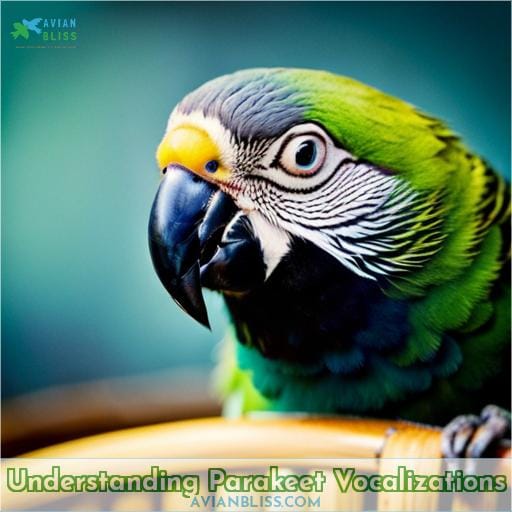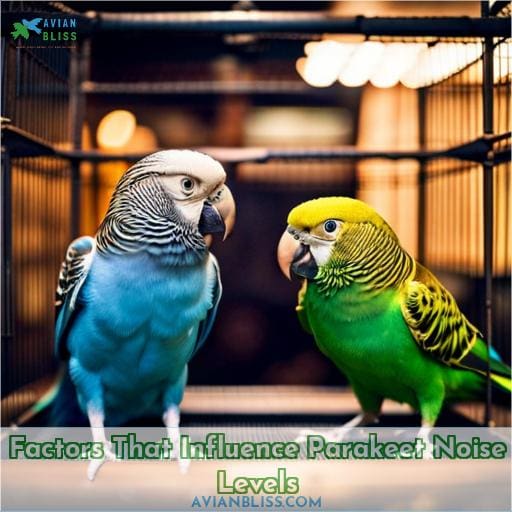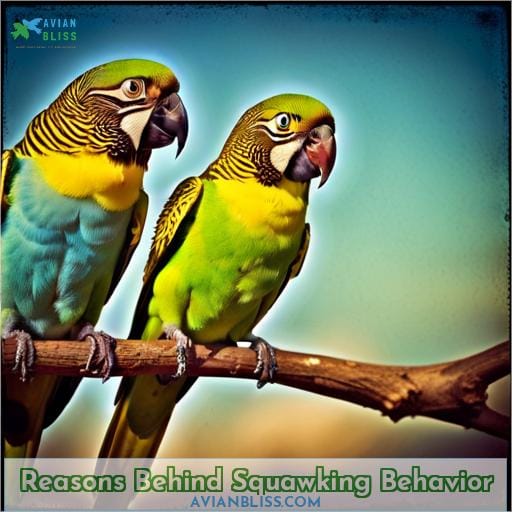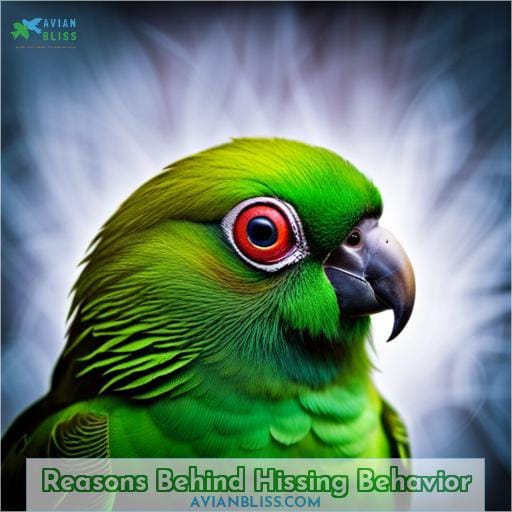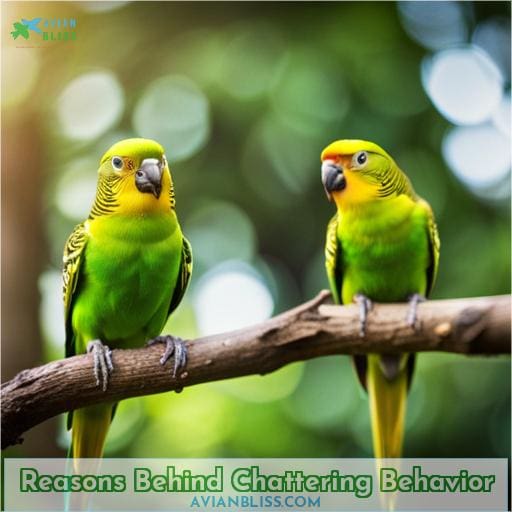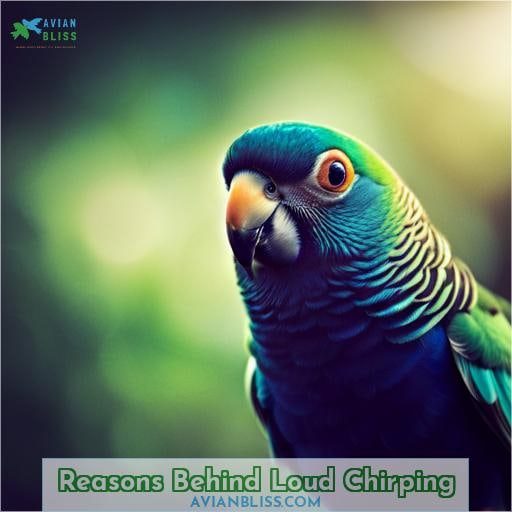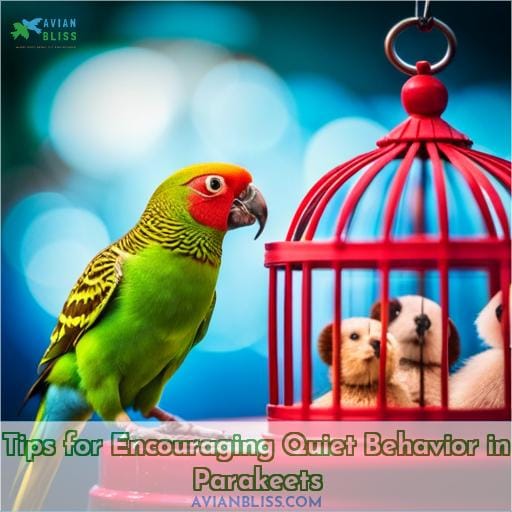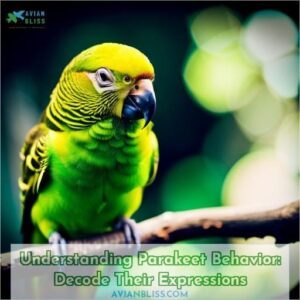This site is supported by our readers. We may earn a commission, at no cost to you, if you purchase through links.
 Imagine living with a parakeet that can’t stop squawking or chirping all day long. It’s enough to drive anyone crazy! But don’t worry, you’re not alone in dealing with the noise.
Imagine living with a parakeet that can’t stop squawking or chirping all day long. It’s enough to drive anyone crazy! But don’t worry, you’re not alone in dealing with the noise.
In this article, we’ll explore whether parakeets are loud and explain the nine different noises they make. From squawking and hissing to singing and chattering, you’ll discover why your feathered friend is making so much racket.
So buckle up for some fascinating insights into the world of noisy parakeets!
Table Of Contents
- Key Takeaways
- Understanding Parakeet Vocalizations
- Factors That Influence Parakeet Noise Levels
- Reasons Behind Squawking Behavior
- Reasons Behind Hissing Behavior
- Reasons Behind Singing Behavior
- Reasons Behind Chattering Behavior
- Reasons Behind Loud Chirping
- Signs of Unhappy Tweets and Their Causes
- Beak Grinding and Its Meaning
- Tips for Encouraging Quiet Behavior in Parakeets
- Frequently Asked Questions (FAQs)
- How can I tell if my parakeet is just making noise for attention versus indicating distress?
- What are some effective methods to train my parakeet not to make loud noises very early in the morning?
- Is it normal for my parakeet to make popping noises with its beak frequently throughout the day?
- My parakeet seems to chatter more loudly when I have guests over. How can I curb this behavior?
- Are there any health conditions that could lead to an increase in squawking or other loud vocalizations in parakeets?
- Conclusion
Key Takeaways
- Squawking can be a sign of fear, hunger, injury, or communication with other birds.
- Hissing is a warning sign of discomfort or the need for personal space.
- Singing denotes joy and pleasure.
- Loud chirping can be a sign of hunger, loneliness, a desire for attention, or simply joy and excitement.
Understanding Parakeet Vocalizations
When it comes to understanding parakeet vocalizations, there are several key noises to pay attention to:
- Squawking is often associated with fear, hunger, mating season, or injury.
- Hissing serves as a warning when your parakeet feels uncomfortable or crowded.
- Singing denotes happiness and contentment.
- Chattering predominantly occurs during the mating season.
- Loud chirping can signal joy, hunger, loneliness, or a call for attention.
Squawking
Squawking is a common form of vocalization in parakeets, and it can indicate various emotions or needs. Understanding the meaning behind their squawks is essential for proper care and communication with your feathered friend.
If your parakeet’s squawking seems distressing, try to decode the source of their distress and address it promptly.
Providing a safe environment, meeting their basic needs, and engaging with them can help reduce excessive noise and create a peaceful atmosphere for noise-free birdkeeping.
Hissing
When a parakeet hisses, it’s expressing its discomfort or need for personal space. Hissing serves as one of their communication cues and warning signals to let others know they’re feeling uncomfortable or crowded.
Parakeets also use hissing during inter-bird talks with other birds, conveying various messages through this vocalization. Understanding the meaning behind their hissing can help in noise management and ensuring their emotional well-being.
Singing
As we continue to explore the vocalizations of parakeets, let’s delve into their singing behavior and what it signifies.
Parakeet singing isn’t just a melodic communication, but also an expression of harmonious contentment. Their cheerful tunes fill the air with environmental serenades that bring songbird satisfaction to both parakeets and their human companions.
Understanding the psychology behind their vocalizations can help us appreciate these delightful melodies even more.
Chattering
You may notice that parakeets engage in chattering behavior to communicate during the mating season. This vocalization serves as a way for them to express their social interaction and readiness to mate.
Understanding why parakeets chatter can help you create an enriched environment for your feathered friend. Consider incorporating behavioral training techniques, providing environmental enrichment through cage setup, and taking into account health considerations when addressing their chattering needs.
Chirping
Now let’s delve into the fascinating world of chirping, a common vocalization among parakeets that plays an important role in understanding their communication.
Parakeets use melodic chirping to express joy, hunger, loneliness or as a call for attention.
They may also engage in interactive chirping to communicate with other birds.
Interestingly, some parakeets even exhibit nocturnal chirping patterns during sleep.
These morning serenades and unusual chirping patterns add charm and liveliness to your feathered friend’s repertoire of sounds.
Factors That Influence Parakeet Noise Levels
Let’s explore the factors that can influence the noise levels of parakeets.
One factor to consider is the time of day, as parakeets tend to be more active and vocal during certain hours.
Another important factor is their roosting behavior, which can contribute to increased noise levels during specific times, such as sunset gatherings.
Additionally, environmental stimuli play a role in influencing their vocalizations, with various sounds or disturbances triggering different responses from these birds.
Time of Day
During certain times of the day, parakeets can become quite vocal.
In the morning, you may wake up to their cheerful serenades as they greet the new day.
As evening approaches, be prepared for a bit of commotion as they socialize and settle down for the night.
Midday tends to bring about a period of quietude where your feathery friends take some time to rest and recharge.
And don’t forget about nighttime chirping or even an enchanting dawn chorus that signifies a fresh start each morning!
Roosting Behavior
As parakeets roost, their behavior and surroundings play a significant role in determining the noise levels they produce.
Nighttime disturbances can affect their vocalizations, with increased noise patterns during communal roosting.
These gatherings of parakeets can create a unique soundscape within urban environments.
It’s interesting to note that this phenomenon has historical context, as the presence of parrots in certain areas has evolved and spread over time.
Understanding these factors can help us better comprehend and appreciate our feathered friends’ noisy habits.
Environmental Stimuli
To understand the factors that influence parakeet noise levels, consider how environmental stimuli can impact their vocalizations.
Parakeets are highly sensitive creatures and loud noises in their surroundings can easily trigger them to squawk or chirp loudly.
Common environmental stimuli that may contribute to increased noise levels include sudden loud sounds such as thunderstorms, fireworks, or even household appliances like vacuum cleaners.
These unexpected bursts of sound can startle parakeets and cause them to express themselves through louder vocalizations.
Reasons Behind Squawking Behavior
When it comes to parakeets and their squawking behavior, there are a few key reasons behind it.
Firstly, fear, hunger, and injury can all trigger squawking as a means of communication.
Additionally, parakeets may engage in vocalizations to communicate with other birds in their environment.
Lastly, addressing unwanted noise is an important aspect of understanding why parakeets squawk and how we can help create a quieter environment for them.
Fear
When experiencing fear, parakeets often express their distress through squawking. Coping with fear is crucial for these sensitive birds, and understanding the reasons behind their behavior can help alleviate anxiety.
Fear-based training techniques should be avoided in favor of creating comfort and overcoming anxiety.
Providing a safe environment, engaging in positive interaction, and offering fear-related enrichment can all contribute to helping parakeets feel more secure and reduce excessive squawking.
hunger
If you’ve ever wondered why your parakeet squawks, it could be because they’re expressing their hunger. Parakeets have specific feeding habits and nutritional needs that require regular meals. During mealtime, they may exhibit certain behaviors like squawking to get your attention and let you know it’s time to eat.
They might even have favorite treats that they eagerly chirp for. However, it’s important to monitor their eating habits as excessive or disordered eating can lead to potential eating disorders in parakeets.
| Feeding Habits | Nutritional Needs | Mealtime Behaviors |
|---|---|---|
| Regular meals | Balanced diet | Squawking |
and injury.
When parakeets squawk, it can indicate fear, hunger, or injury. Vocalization variations in their squawking can provide clues to their emotional state.
Environmental influences such as loud noises or sudden changes in the surroundings may trigger increased squawking behavior.
Injuries can also lead to vocalizations of distress and pain.
Understanding these behavioral triggers is crucial for addressing the needs of your parakeet and providing appropriate care.
Building an interactive bonding with your pet helps minimize stress-related vocalizations while implementing noise reduction strategies creates a calm environment for both you and your feathered friend.
Communication with birds.
To communicate with other birds, parakeets often use squawking as a form of vocalization. Their ability to communicate through various sounds highlights their avian intelligence and complex vocalization patterns.
Squawking serves as a behavioral trigger in response to fear, hunger, injury or during inter-species communication attempts. Environmental influences can also play a role in triggering these vocalizations.
Understanding the reasons behind squawking behavior allows for better communication and interaction with our feathered friends.
Addressing unwanted noise
To address unwanted noise caused by squawking behavior in parakeets, you can take certain steps to create a quieter and more peaceful environment.
Noise reduction can be achieved by providing a spacious cage environment that minimizes stressors.
Identifying the causes of distress, such as fear or hunger, and promptly attending to their needs can reduce attention-seeking behaviors.
Interactive solutions like engaging with your parakeet through training and playtime can also help curb excessive squawking.
Reasons Behind Hissing Behavior
When it comes to parakeets, hissing behavior serves as a warning sign that they’re uncomfortable or feeling crowded. It’s their way of communicating the need for personal space and expressing their discomfort.
Additionally, hissing can also be an attempt at communication with other birds, conveying various messages from danger to readiness to mate.
Warning signs of discomfort
Experiencing discomfort, parakeets may exhibit hissing as a warning sign. This vocalization analysis is crucial in understanding their behavioral cues and comfort indicators.
Hissing serves as a communication method for parakeets to express their need for personal space or to signal discomfort. By recognizing these signs, you can take steps towards noise reduction and creating an environment of harmony that promotes the well-being of your feathered friend.
Need for personal space
When parakeets are feeling crowded or uncomfortable, they may exhibit a need for personal space by hissing. This behavior is their way of communicating their discomfort and asserting boundaries.
Understanding the dynamics of personal space can help minimize noise levels and create a harmonious environment for both you and your feathery friend.
Providing free zones in the cage, modifying behavior through training techniques, and designing an appropriate cage layout can all contribute to promoting a sense of personal space for your parakeet.
Communicating with other birds
When parakeets feel crowded or uncomfortable, they use hissing as a warning sign to communicate with other birds about their lack of personal space. While some subtle variation exists between species, most parakeets understand key elements of avian vocal dialects and participate in complex cross-species conversations.
The hissing sound signifies discomfort and the need for more area, conveying important behavioral cues in a type of social bird language. Understanding this vocalization helps provide context around a parakeet’s environment and relationships.
Reasons Behind Singing Behavior
You will often hear your parakeet sing happily when content. Singing denotes joy and pleasure in parakeets.
To encourage more singing, engage positively and provide a comfortable environment for your bird.
Vocalization as communication
Your parakeet’s singing manifests its attempt to communicate with you or other birds. The nuances in vocalization convey subtleties beyond just noise. Listen closely to detect the emotional expressions woven into their songs.
These melodies enable dialogues between individual birds and signify various needs.
Reasons for singing
Your parakeet’s singing denotes happiness and contentment within its environment.
Singing isn’t just a mere act of making noise; it’s a form of melodic communication that reflects the vocalization psychology of your feathered friend.
When your parakeet bursts into song, it’s expressing its mood-driven melodies and conveying a sense of harmonious happiness.
The satisfaction they derive from singing can be seen in their joyful tunes, filling your home with delightful sounds.
Addressing unwanted noise
To address unwanted noise caused by singing behavior in parakeets, you can take certain steps.
- Covering cage: Use a blanket or cover to provide security and minimize external stimuli.
- Cage size: Ensure adequate space in the cage to reduce fights among parakeets.
- Prompt attention: Attend promptly to their basic needs like food, water, and cleaning.
- Engage with your parakeet: Interact regularly through playtime or training sessions to fulfill their need for attention.
By implementing these techniques, you can encourage quieter behavior from your noisy little companion while maintaining a harmonious atmosphere in your home.
Reasons Behind Chattering Behavior
When it comes to parakeets’ chattering behavior, there are a few key reasons behind it.
- One of the main reasons is that chattering often occurs during the mating season as a way for parakeets to communicate and attract potential mates.
- Additionally, squawking and fear can also play a role in their chattering behavior, as they may use this vocalization to express discomfort or signal danger.
Understanding these reasons can help you better interpret your parakeet’s behaviors and provide them with the appropriate care and attention they need during these times.
Chattering during mating
When parakeets engage in their chattering behavior during mating, it’s an instinctual way for them to communicate and express their readiness to reproduce. This chattering serves a purpose in attracting mates and is often characterized by its frequency, volume, and duration.
During the mating season, parakeets can be heard creating lively chatter that echoes through flocks as they participate in this exciting mating ritual.
| Causes | Excitement |
|---|---|
| Mating Season | Attracting Mates |
Squawking and fear
When parakeets experience fear, they often express it through squawking noises.
Squawking is one of the different types of squawks that these birds use to communicate their emotions and needs.
It can also be a response to injury or danger in their environment.
Additionally, during mating season, male parakeets may engage in loud squawking as a way to attract mates.
Understanding the reasons for squawking can help you better care for your feathered friend and address any underlying concerns.
Addressing unwanted noise
If you’re dealing with unwanted noise from your parakeet, addressing the reasons behind their chattering behavior is essential.
To reduce noise and create a sense of security for your bird, try covering part of the cage with a blanket.
Make sure to provide enough space in the cage to prevent fights and excessive noise.
Investigate potential causes for distress and promptly attend to their needs.
Engage with your parakeet through training and use comforting tones to encourage quiet behavior while understanding their vocalizations as a way they communicate their needs.
Reasons Behind Loud Chirping
When it comes to parakeets, their loud chirping can have various reasons behind it. Understanding these causes is essential in addressing excessive noise and encouraging quieter behavior. By identifying the factors that contribute to their loud chirping, you can create a more peaceful environment for both yourself and your feathered friend.
Causes of loud chirping
As we delve into the subtopic of ‘Causes of loud chirping (Reasons Behind Loud Chirping)’, let’s explore what prompts parakeets to engage in this vocal behavior.
Parakeets may chirp loudly due to:
- Hunger
- Loneliness
- A desire for attention
- Simply out of joy and excitement.
It serves as a form of communication for them, expressing their needs and emotions.
Dealing with excessive noise
To address excessive noise caused by loud chirping, you can take specific steps to create a calmer environment for your parakeets.
- Covering the cage partially with a blanket provides security and reduces visual stimuli that may contribute to the noise.
- Ensuring adequate space in the cage helps prevent fights and excessive noise.
- Investigate potential causes of distress and promptly attend to their basic needs.
- Engage with your parakeet through training and interaction to foster a calmer demeanor, reducing unnecessary noise.
Encouraging quiet behavio
Encourage your parakeet to exhibit quieter behavior by addressing the underlying causes of loud chirping.
Provide a secure, spacious cage.
Promptly attend to needs.
Use blanket covers for security.
Engage in training and interaction to foster calm.
Utilize soothing tones that comfort and relax your bird.
Meeting basic requirements and building trust curbs attention-seeking noise.
Signs of Unhappy Tweets and Their Causes
When your parakeet starts tweeting loudly or making distressed cries, it’s signalling unhappiness. Pay close attention to body language and vocal tones that convey anxiety, fear or discomfort. Determining the root cause of your bird’s distress allows you to promptly address its needs and quiet any unhappy tweets.
Unhappy tweets and causes
Experiencing unhappy tweets from your parakeet can be a clear indication that something is causing distress or dissatisfaction.
Different types of tweets, such as squawking, hissing, or chattering, can vary in volume and frequency depending on the context.
Unhappy tweets may last for varying durations and could signal fear, discomfort, hunger, or even a need for personal space.
Understanding these signs and addressing your bird’s needs promptly can help alleviate their unhappiness and create a happier environment for both of you.
Signs of distress
If your parakeet is exhibiting signs of distress, such as unhappy tweets or unusual behavior, it’s important to address their needs and potential causes for discomfort.
Signs of distress in parakeets can include:
- Beak grinding
- Feather plucking
- Self-mutilation
- Panting
- Wing flapping
These behaviors may indicate that your bird is experiencing stress or physical discomfort. It’s crucial to observe these signs closely and consult with a veterinarian if necessary to ensure the well-being of your feathered friend.
Addressing bird’s needs
When your parakeet is expressing unhappy tweets, it’s important to address their needs promptly and effectively.
Providing a cage cover can offer them security and reduce stress.
Investigate the cause of their distress, whether it’s hunger, loneliness, or discomfort.
Prompt attention to their basic needs like food and water can help quiet the environment.
Interacting with your parakeet through training sessions or playtime can also alleviate boredom and reduce attention-seeking noise.
Beak Grinding and Its Meaning
While unhappy tweets and grinding beaks can both signal distress in parakeets, beak grinding specifically indicates contentment as parakeets grind their beaks to self-soothe and relax.
You’ll notice your parakeet grinding its beak when it’s settling in for a nap or just sitting still and at ease.
Beak grinding also frequently occurs when a parakeet is receiving gentle strokes on the head and neck since this physical contact brings comfort and pleasure.
Some grinding while eating indicates enjoyment of the food.
Excessive grinding could suggest something amiss so look for other signs of distress like loss of appetite, lethargy, or fl■ feathers.
But gentle, occasional beak grinding during calm moments most often conveys a serene, gratified parakeet.
Tips for Encouraging Quiet Behavior in Parakeets
Two effective ways to encourage quieter behavior in your parakeets are providing them with a spacious cage and engaging with them through training and playtime.
- Provide a safe and secure environment.
- Give them plenty of room to move around and multiple perches at different heights. This reduces territorial behavior and fights.
- Attend promptly to their needs.
- Ensure they’ve adequate food and water, proper lighting and temperature, and a clean cage. This prevents prolonged loud vocalizations.
- Use positive reinforcement during handling and training.
- Reward quiet and calm behavior with treats and praise. This fosters a more relaxed demeanor.
Regular interaction and a comfortable living space keep parakeets content. Meeting their needs quickly also prevents attention-seeking noise. Positive reinforcement through training facilitates calmness. With some effort, you can have happy, quieter parakeets.
Frequently Asked Questions (FAQs)
How can I tell if my parakeet is just making noise for attention versus indicating distress?
Pay attention to the situation.
Is their environment meeting all needs?
If so, try engaging them or briefly covering the cage.
Loud noises when cared for likely seek your interaction.
However, consistent, distressed vocalizations require examining and addressing potential causes.
What are some effective methods to train my parakeet not to make loud noises very early in the morning?
To train your parakeet to be quiet in the early morning,
- Create a calm and cozy environment by covering part of their cage.
- Engage with them during the day to reduce attention-seeking noise.
Is it normal for my parakeet to make popping noises with its beak frequently throughout the day?
Yes, it’s normal for parakeets to make popping noises with their beaks throughout the day.
It can be a sign of contentment or just a playful behavior.
Enjoy these little quirks!
My parakeet seems to chatter more loudly when I have guests over. How can I curb this behavior?
When your parakeet gets extra chatty around guests, it’s likely seeking attention. To curb this behavior, provide a secure and spacious environment, address its needs promptly, and engage with it regularly to reduce the need for attention-seeking noise.
Are there any health conditions that could lead to an increase in squawking or other loud vocalizations in parakeets?
Excessive squawking or loud vocalizations in parakeets can be a sign of health issues such as pain, discomfort, or stress.
It’s important to observe their behavior and consult with a veterinarian for proper diagnosis and treatment.
Conclusion
You feel like you’re living with a feathered alarm clock. The constant squawking and chirping of your parakeet has you on edge.
By providing a secure environment and fulfilling their needs, you can curb unwanted vocalizations. With some patience and by addressing causes, your home can become a calmer place. Don’t lose hope, together you’ll find a harmonious balance with your chatty companion.

